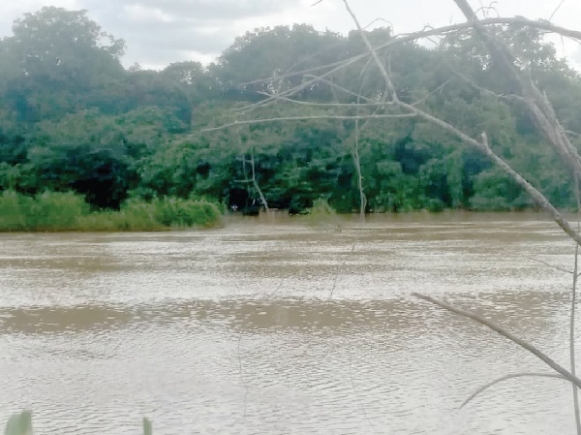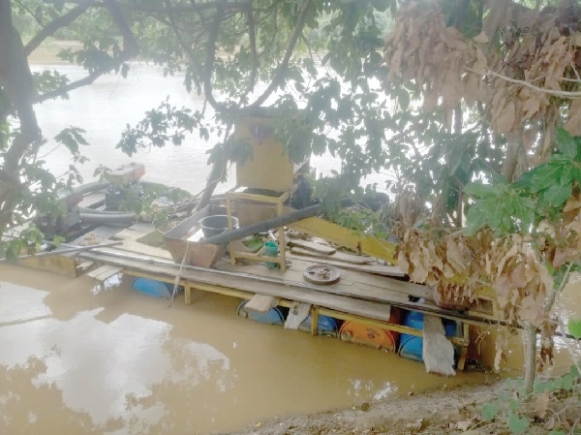
It is said that “water is life”, and rightly so, water bodies are a source of life as communities depend on them largely for their livelihoods.
However, many water bodies in Northern Ghana are currently under siege from illegal mining activities that are polluting them and causing harm to aquatic life.
Illegal mining popularly known as ‘galamsey’ is deep rooted and causing havoc to rivers, lakes, streams and swathes of land and forest reserves in the area.
The uncontrolled galamsey activities are polluting the water bodies with toxic chemicals such as mercury, cyanide and other harmful substances.
Just like in Southern Ghana, many water bodies are being polluted with impunity in the north with local communities bearing the brunt of the menace.
Situation
For the past three weeks, the Daily Graphic’s visits to a number of mining areas in the Upper West, Upper East and Savannah Regions have uncovered that illegal miners who are said to be both locals and foreigners have been engaging in the activities on and along the banks of many water bodies, calling the bluff of community leaders and authorities.
The areas are Wechiau, Tangasie, Lawra, Cheripkong, Zongoyire, Jama, Jugboi, Carpenter and Bamboi communities, all along the Black Volta River.

At the Wechiau enclave in the Wa West District, the illegal miners have mounted their equipment on the Black Volta River, digging for gold from the bed of the water body.
The colour of the river had become brownish and thick, or to best describe, it had become like ‘Tom Brown’ porridge – thick and dull.
With a careful view, one could see some traits of dirty oil on the surface of the river, seemingly from the changfan machines and other equipment used by the illegal miners.
Threat to Sanctuary
What is more worrying is, they had descended heavily on the Wechiau Community Hippo Sanctuary, the only developed and oldest tourist site in the Upper West Region.
Established in 1998, the sanctuary is home to more than 50 hippopotamuses, 250 bird species, various plant species and living creatures.
The once beacon of conservation and cultural heritage faces a dire threat from illegal mining activities as they have mounted equipment around the sanctuary undertaking their activities.
Their destructive activities have left visible scars on the landscape, disrupting the fragile ecosystem and endangering the unique biodiversity of the sanctuary.
The Manager of the Wechiau Hippo Sanctuary, Abdullah Issahaku, expressed worry about the growing phenomenon and said the galamsey activities were not just a threat to the sanctuary but also to the lifeblood of the community.
“The Wechiau Hippo Sanctuary is one of the developed tourist sites in the Upper West Region. But the illegal miners are defying all odds and advancing into the protected zone of the sanctuary which is within the Black Volta River to mine,” he lamented.

For the past years, he said a number of community members have been depending on the sanctuary for their livelihood as it had empowered more than 2,000 people, particularly women, through skills training and provision of capital to start their businesses.
Mr Issahaku, therefore, appealed to authorities to help protect the tourist site and the Black Volta River from the activities of illegal miners.
Security Operation
In an interview with the Daily Graphic, the District Chief Executive for Wa West, Vida Diorotey, indicated that the assembly got wind of the activities of the illegal miners recently and swiftly deployed a team of security operatives to flush them out of the area.
However, she said she had since received reports that the miners had returned to the protected site with heavy equipment to resume their activities, adding that “the last time the security stormed the site, the illegal miners fled into the bush and they destroyed all their equipment”.
“I have convened a District Security Committee with all the various security heads and stakeholders to deliberate on how to stop the menace.
I will be deploying a team of security personnel to chase them out from the place in the coming days. The Wechiau Hippo sanctuary is the only developed tourist site in the district which is attracting revellers from all over the world, so the assembly will do everything possible to protect it,” she pointed out.
Galamsey Surge
The Black Volta takes its source from Burkina Faso and flows north and east for about 200 miles (320 km) and then turns south for 340 miles (550km), forming the border between Ghana and Burkina Faso, and also between Ghana and Côte d’Ivoire.
At the Bamboi enclave in the Savannah Region, the Black Volta turns north and east, and approximately 80 miles (130km) farther east and empties into Lake Volta.
The illegal mining activities are gaining notoriety along the river. The activities have destroyed the integrity of the river with dire consequences on critical infrastructure such as the Bui Power Generation Dam and Akosombo Power Generation Dam downstream.
In 2023, the Ministry of Lands and Natural Resources deployed a team of security operatives to deal ruthlessly with all persons engaged in illegal mining in the Black Volta.
However, checks by the Daily Graphic revealed that some of the illegal miners have returned to the area, covertly undertaking the mining activities.
Livestock Dies
The situation was not different at Zongoyire, a mining community in the Bawku West District in the Upper East Region where the White Volta River has been badly polluted by the ‘galamsey’ operators.
The illegal miners have contaminated the fish-laden water with poisonous cyanide, thereby killing the fishes in that part of the river and rendering the water unwholesome for inhabitants and livestock around the area.
But in the midst of this, livestock farmers are bearing the brunt as many animals continue to die from drinking the contaminated water from the river and other water bodies within the mining community, according to community members.
“I have lost five livestock since last year. Apparently, they drank the water contaminated by the harmful chemicals and died. Initially, I didn’t know it was the water causing that. It was through the veterinary officers that I got to realise it,” Mahamudu Akurugu told the Daily Graphic.
He added that the situation had made rearing of animals very difficult because all the water bodies that they used to drink from were polluted.
Another farmer, Ibrahim Salifu, who shared similar frustration appealed to authorities to as a matter of urgency halt the illegal mining activities and protect the water bodies in the area.
For, the Assemblyman for the Zongoyire Electoral Area, Thomas Akurugu, the consequences of the galamsey activities were dire as the lives of the community members revolved around the White Volta and other water bodies.
He corroborated claims by the residents that some livestock had died after drinking the contaminated water, adding that “Now we are all scared of drinking from rivers, streams and other water bodies. We drink from the few boreholes”.
Contamination
A recent test conducted on the White Volta River that stretches through Northern Ghana and empties into the Volta Lake revealed high levels of dangerous heavy metals due to illegal mining activities.
The tests, conducted by the CSIR-Water Research Institute and TAMA Foundation Universal, showed high levels of mercury, cadmium, lead, iron, chemical oxygen, arsenic and manganese in the water.
The findings showed that there were chemical oxygen demand levels of 1135mg/l; Iron 0.977mg/l; manganese 2.635mg/l; arsenic 1.45mg/l; cadmium 0.132mg/l and chromium 0.8mg/l, as against 250, 0.3: 10, 0.4, 0.010: 1.0, 0.003: 0.1 and 0.05: 0.1 respectively, as recommended levels by the World Health Organisation (WHO) and Environmental Protection Agency (EPA).
Additionally, the tests revealed high contamination of bacteria in water bodies in all mining areas in northern Ghana.
For instance, the data analysis of water bodies at communities such as Sheini, Nangruma, Bulinga, Nangodi and Kandema, among other areas, revealed a prevalence of total and faecal coliforms of 100 and 81 per cent; E. coli and faecal enterococci, 18.75 per cent; pseudomonas aeruginosa, 31 per cent, and clostridium perfringens, six per cent.
Threat
The Upper East Regional Director of the Environmental Protection Agency (EPA), Dr Asher Nkegbe, said contaminated water bodies posed health risks to people who depended on them for their livelihoods, as well as aquatic lives.
“Illegal mining is a very serious issue that is causing harm to the environment in the region. It is a very complex issue so it needs concerted efforts and collaboration. We have been collaborating with all the various stakeholders to address the menace and protect the environment,” he stated.
Environmental Disaster
The contamination of water bodies is not just a community-based issue but a broader environmental disaster. This is because Aquatic life crucial for maintaining ecological balance is being decimated.
An Environmental Activist, Dr Chrys Anab, said illegal mining was gaining notoriety in the region with its attendant consequences on water bodies.
He called for strict enforcement of the laws and regulations on water bodies, as well as the adoption of pragmatic measures to address the situation.
Achieving SDGs, Way Forward
The rivers, lakes, streams and other water bodies, once vital sources of life and livelihood, are now at risk of becoming irreversible casualties of galamsey.
The health of these water bodies is not just a matter of environmental concern but a critical issue affecting the well-being and future of local communities.
Goal Six of the Sustainable Development Goals (SDGs) seeks to ensure safe drinking water and sanitation for all, focusing on the sustainable management of water resources, waste water and ecosystems, and acknowledging the importance of an enabling environment by 2030.
In the same vein, goal 15 is envisaged to protect, restore and promote sustainable use of terrestrial ecosystems, sustainably manage forests, combat desertification, halt and reverse land degradation and also halt biodiversity loss.
However, the indiscriminate destruction of the water bodies by illegal miners paints a gloomy picture of the country’s quest to achieve these goals by 2030.
There is, therefore, the need for authorities to put in place effective measures including regulatory enforcement and community engagement to safeguard the region’s precious water bodies.
Writer’s email:mohammed.fugu@graphic.com.gh
System Summary
The cost of gold: Illegal mining activities destroy water bodies, terrestrial ecosystems
The article explores the detrimental effects of illegal gold mining in Ghana, focusing on the destruction of water bodies and terrestrial ecosystems.
It discusses the environmental damage, including water pollution and deforestation, and the socio-economic impacts on local communities.
The piece reviews government and policy responses and calls for stronger regulations and community involvement to combat illegal mining and safeguard Ghana’s natural resources and public health.
Story By: Mohammed Fugu
Source: Graphic.com

Leave A Comment